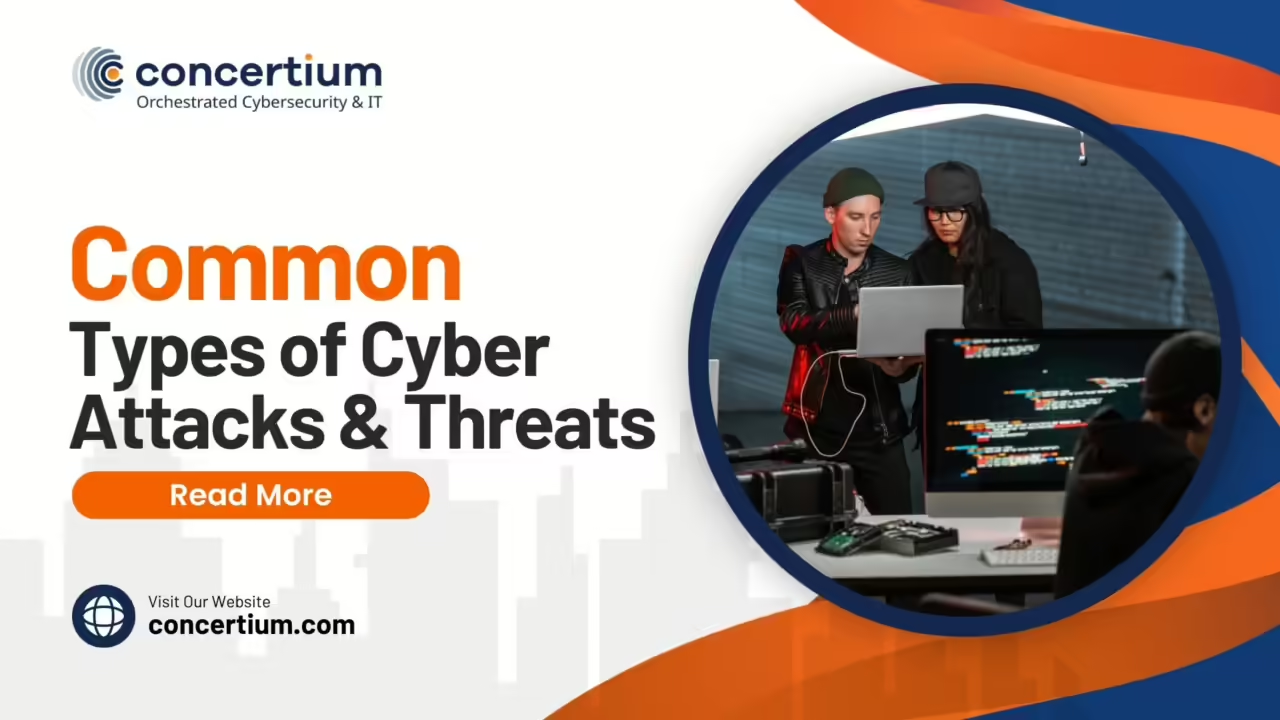What Are Common Types of Cyber Attacks?
A cyber attack refers to a malicious attempt by cybercriminals to damage, steal, or gain unauthorized access to systems, networks, or data. These attacks are carried out using a variety of tactics that exploit vulnerabilities in security systems. Cyber attacks have become increasingly sophisticated and can result in significant financial and reputational damage to organizations. Understanding the different types of cyber-attacks and implementing strong security measures is essential for safeguarding against potential threats.
Active and Passive Cyber Attacks
Active Cyber Attacks
Active cyber attacks involve direct interference or alteration of a system’s functionality. In these scenarios, the attacker actively engages with the target to modify, disrupt, or damage data and processes. Active attacks include malware infections, phishing, and distributed denial-of-service (DDoS) attacks. For example, in a malware attack, a hacker deploys malicious software to alter the system’s performance or steal data. Similarly, in a phishing attack, a deceptive email is used to manipulate the victim into divulging sensitive information.
Passive Cyber Attacks
Passive cyber attacks, on the other hand, involve monitoring or eavesdropping on system activities without altering or damaging the systems. These attacks are primarily focused on gathering information and can go undetected for long periods. Examples include eavesdropping attacks and man-in-the-middle (MITM) attacks, where attackers listen in on the communication between two parties to steal sensitive information without leaving a trace.
Common Types of Cyber Attacks
Phishing Attacks
Phishing is a type of social engineering attack where attackers send deceptive emails or messages that appear to be from legitimate sources. The goal is to trick recipients into clicking on malicious links, downloading infected files, or revealing personal information such as usernames, passwords, or financial data. Phishing attacks are one of the most common types of cyberattacks and come in various forms, including spear phishing (targeted attacks on specific individuals or organizations) and whale phishing (targeting high-profile executives). Cybercriminals use phishing as a gateway for password attacks or to plant malware in the target’s computer network, making it a preferred tactic for initiating various types of cyberattacks.
Malware Attacks
Malware, short for malicious software, is designed to infiltrate and damage a computer network or system without the user’s knowledge. It includes viruses, worms, trojans, and spyware, each with its unique method of causing harm. Once installed, malware can disrupt system operations, steal data, or give the attacker control over the system. Malware is often deployed through phishing attacks or by exploiting vulnerabilities in web applications. Some malware variants, like ransomware, focus on encrypting data and demanding a ransom, while others like spyware, silently collect personal information. In password attacks, malware like keyloggers is used to capture login credentials, giving attackers access to sensitive systems.
Ransomware Attacks
Ransomware is a particularly devastating type of malware that encrypts a victim’s data, rendering it inaccessible until a ransom is paid to the attacker. This attack type often results in operational downtime, financial loss, and reputational damage. Once infected, the victim is presented with a ransom note, usually demanding payment in cryptocurrency. Some attacks target specific industries, using social engineering and brute force techniques to breach systems. Ransomware is commonly spread through phishing emails, where an unsuspecting user downloads the malicious software. With the rise in cyber risks, cybersecurity training is essential to teach employees how to recognize and avoid these threats.
Injection Attacks
Injection attacks, such as SQL (Structured Query Language) injection and cross-site scripting (XSS), occur when attackers insert malicious code into a vulnerable web application. In SQL injection attacks, the attacker manipulates database queries to gain access to sensitive information or control over the database. For example, a successful SQL injection can allow an attacker to retrieve data like usernames, passwords, and other types of data stored in the database. XSS attacks involve injecting scripts into web pages viewed by other users, which can steal session cookies, hijack user sessions, or deface websites. To counter these common cyberattacks, it is crucial to implement strong input validation and use web application security measures to prevent attackers from exploiting vulnerabilities.
Denial-of-Service (DoS) and Distributed Denial-of-Service (DDoS) Attacks
A Denial-of-Service (DoS) attack aims to disrupt the availability of a service by overwhelming it with a flood of requests, making it impossible for legitimate users to access the service. A Distributed Denial-of-Service (DDoS) attack involves multiple compromised systems working together to send excessive traffic to the target, causing similar disruptions on a larger scale. DDoS attacks often leverage botnets to amplify the volume of traffic, making them harder to mitigate. Organizations need cyber security defenses like cloud-based DDoS mitigation tools and advanced monitoring to defend against these attack types. DoS and DDoS attacks are frequently used by cyber criminals to cause service interruptions, extort companies, or disrupt competitors’ operations.
Brute Force and Password Attacks
Brute force attacks involve systematically trying every possible combination of characters until the correct password is found. Attackers use automated tools to test thousands or even millions of passwords per second, targeting weak or common passwords. Password attacks like dictionary attacks rely on lists of common words and phrases to guess credentials. Brute force attacks are especially effective against accounts with simple passwords or no account lockout policies. Strengthening security settings, implementing multi-factor authentication, and monitoring login attempts are crucial to thwart password attacks.
Man-in-the-Middle (MITM) Attacks
Man-in-the-middle attacks occur when an attacker secretly intercepts and alters the communication between two parties without their knowledge. MITM attacks often happen on public networks or unsecured Wi-Fi networks, where attackers eavesdrop on communications or inject malicious content into a session. For example, an attacker on a public Wi-Fi network could capture login credentials or financial information being transmitted between a user and a website. Preventing MITM attacks requires using strong wifi encryption protocols like WPA3, avoiding untrusted networks, and implementing secure communication channels with end-to-end encryption.
DNS Tunneling Attacks
DNS tunneling is a sophisticated type of attack that involves using the Domain Name System (DNS) protocol to transfer data over channels that are not intended for data communication. Attackers encode malicious data within DNS queries, which is then transmitted to the attacker’s server. This covert method allows cybercriminals to bypass cyber security defences and exfiltrate data without detection. DNS tunneling is challenging to detect because DNS traffic is typically trusted and often goes unmonitored. Organizations need robust DNS monitoring and security resources to identify unusual queries and block malicious traffic, making it a critical component of any cybersecurity platform.
By understanding these common types of cyberattacks, organizations can implement a multi-layered approach to security that addresses different attack types and minimizes the risk of falling victim to sophisticated cyber threats.
Insider Threats in Cybersecurity
What are Insider Threats?
Insider threats are cybersecurity risks that originate from within an organization. These threats can come from employees, contractors, or business associates who have authorized access to the organization’s systems. Insider threats are often categorized into malicious insiders (who intentionally cause harm) and negligent insiders (who unintentionally expose the organization to risk through carelessness). Whether intentional or unintentional, insider threats can lead to data breaches, intellectual property theft, and financial loss.
Real-World Examples of Insider Threats
One notable example of insider threats is the case of an employee at a financial services firm who leaked confidential client data to external parties for personal gain. This incident not only damaged the firm’s reputation but also resulted in significant regulatory fines. Another example involves a healthcare worker who inadvertently shared sensitive patient information due to a lack of cybersecurity awareness. Such cases highlight the need for robust access control policies and security awareness training to minimize insider threats.
Social Engineering Attacks
What is Social Engineering?
Social engineering is a technique used by attackers to manipulate individuals into performing actions or revealing confidential information. Rather than exploiting technical vulnerabilities, social engineering preys on human psychology. Attackers may pose as trusted figures, such as IT support, to gain access to credentials or sensitive information. This type of attack often involves persuasion, intimidation, or creating a sense of urgency to achieve the desired outcome.
Phishing as a Type of Social Engineering
Phishing is one of the most common social engineering techniques. In a phishing attack, the attacker crafts a convincing email that appears to come from a legitimate source, such as a bank or employer. The email may contain a link to a fake website that mimics a real one, tricking the victim into entering their login credentials. The stolen information is then used for further attacks, including identity theft or financial fraud.
Attacks and How to Prevent Them: A Guide to Cybersecurity Measures
Preventing Phishing Attacks
Implement Security Awareness Training
Training employees to recognize phishing emails and other social engineering tactics is one of the most effective ways to prevent phishing attacks. Security awareness programs should include simulated phishing tests, practical examples, and guidance on how to handle suspicious emails.
Multi-Factor Authentication (MFA)
Multi-factor authentication adds an extra layer of security by requiring users to verify their identity through additional methods, such as a code sent to their mobile device. This prevents attackers from gaining access to accounts, even if they manage to steal a password.
Preventing Malware and Ransomware Attacks
Use Antivirus and Anti-Malware Solutions
Deploying antivirus and anti-malware software is essential for detecting and removing malicious software before it causes damage. Organizations should ensure that these solutions are regularly updated to address new threats.
Regular Data Backups
Maintaining regular backups of critical data can minimize the impact of a ransomware attack. By keeping backups in a secure, offline location, organizations can restore data without paying a ransom.
Patch Management and Software Updates
Ensuring that all software and systems are up-to-date with the latest security patches can help prevent malware infections that exploit known vulnerabilities.
Preventing Injection Attacks
Secure Coding Practices
Developers should implement secure coding practices, such as input validation and using prepared statements, to prevent SQL injection and other types of injection attacks. These practices ensure that user inputs are sanitized and do not include malicious code.
Web Application Firewalls (WAFs)
Web Application Firewalls protect web applications by filtering and monitoring HTTP traffic between a web application and the internet. WAFs can block malicious traffic and provide real-time alerts for potential injection attacks.
FAQs
What are the most common types of cybersecurity attacks?
The most common types of cybersecurity attacks include phishing, trojan attacks, ransomware, injection attacks, and DoS or DDoS attacks. These attacks exploit weaknesses in a computer or network to gain unauthorized access, disrupt services, or steal sensitive information.
What is a phishing attack, and how does it work?
A phishing attack is a common method of social engineering where attackers send deceptive emails designed to trick individuals into revealing sensitive information like their usernames and passwords. It includes various forms, such as whale-phishing attacks that target high-profile individuals like executives. The goal is often to gather credentials or deploy a malicious piece of software.
What is a DoS or DDoS attack?
A DoS (Denial-of-Service) or DDoS (Distributed Denial-of-Service) attack involves overwhelming a computer or network with excessive traffic to disrupt its normal functioning. In a DDoS, a botnet is a network of compromised devices that work together to send a flood of requests, making it difficult for legitimate users to access the service.
What is DNS tunneling?
DNS tunneling is an advanced method where attackers use the Domain Name System protocol to covertly transfer data between systems. By embedding malicious data in DNS queries, attackers establish a hidden communication session between a client and their server, often evading traditional security controls.
How can security teams prevent cyber attacks?
Security teams can prevent cyber attacks by using Security Information and Event Management (SIEM) systems for real-time monitoring, implementing zero-day attack defenses, and ensuring robust endpoint protection. Training and awareness programs are also essential for defending against multiple types of cyber threats.
Understanding and mitigating the diverse types of cybersecurity attacks is essential for maintaining robust digital security. With cyber threats ranging from phishing and trojan attacks to sophisticated zero-day attacks, organizations must adopt a proactive approach. Leveraging technologies like SIEM and ensuring that security teams are equipped to handle DoS or DDoS attacks and DNS tunneling are critical components of an effective defense strategy. Regular security updates, employee training, and a layered security framework will significantly strengthen an organization’s ability to prevent cyber attacks and protect against evolving threats in the cybersecurity landscape.






